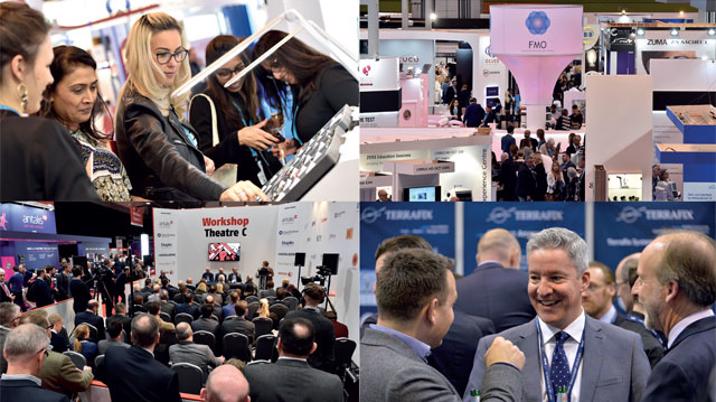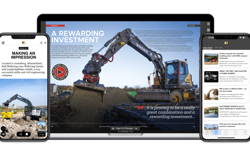
Once an opportunistic add-on for publishers eager to sweat their content harder, events have become big business – perhaps nowhere more so than at PrintWeek Live! organiser MA Exhibitions Ltd, the exhibitions company established by Mark Allen Group (MAG) in 2015 which, in just two years, has turned a modest events-based side-line into a fast-growing, £12 million turnover, standalone business.
“There is a huge opportunity in events for many small to medium-sized publishers – even in today’s marketplace,” says MA Exhibitions managing director Ed Tranter.
“Print sales might be struggling or falling in favour of online, but publishers of all sizes are well-positioned against pure-play event organisers because you struggle to produce good editorial and cannot readily access data if you don’t own your own magazines.”
MA Exhibitions’ roots lie in Findlay Media, the specialist manufacturing and engineering industry business-to-business publisher acquired by MAG in 2014, which was last year renamed MA Business following a group corporate restructure.
As a founding director of Findlay Media, Tranter had begun expanding that company’s events portfolio with the successful launch of The Engineering Design Show and Manufacturing & Engineering North East. He then set about expanding the events strategy further under new ownership from MAG’s distinctive head office based in a converted church in London’s Herne Hill.
“At Findlay Media, we had eleven magazines and ran small conferences and events - like awards. But around 2012, when many new shows were being developed in our marketplace and we realised they depended on us for their data, marketing and editorial coverage, we thought: why not do more ourselves?” he recalls.
“There was some nervousness as we’d not done things on a bigger scale before, but we did it – establishing a number of new shows. Then, after we were acquired and Mark said that as a business with lots of enthusiasm and 66 brands he would like to focus more on exhibitions, we created MA Exhibitions.”
At that point, Tranter and a handful of staff had just two events and a turnover of just under £1m. Two years on, however, MA Exhibitions now has a team of around 50; runs 27 of its own events spanning four continents and almost every business sector you care to mention – plus contracts to run a number of the 200 or so events MAG brands run each year; and turnover has grown by more than ten-fold.
Tranter outlines three different strands that are powering the company’s growth: creating events from magazine brands; managing events for third party associations; and acquiring events. In each case, it works with third party specialist suppliers with whom it has established close working partnerships to deliver the experience on the day.
Creating events, however – with an emphasis on what Tranter describes as “annual events with focus”, that run just for one or two days – is the business’s cornerstone and much of its success in this respect comes down to one thing: doing its homework.
Talk to the right people
“Many companies – and I have worked for a number of them – typically sit three people in a room and say: ‘I know my market and this is what they want’. And the first their market hears about it is when they are being sold a brochure and a floorplan,” he explains.
Instead, MA Exhibitions speaks first not to potential exhibitors with the deepest pockets but likely attendees to understand their wants and needs. The team then discusses these with the companies they hope will sponsor an event or buy exhibition space before honing a proposition designed to meet all parties’ interests.
The aim is to have up to 20% of the show floor sold and headline sponsors in place before announcing any new show’s launch.
“Companies have to promote themselves, and once you’ve accepted that fundamental truth, it’s all about participants’ requirements,” Tranter says.
“That’s why we’d never go first to the people with money at the big suppliers, ask them what they want then promise to deliver it: that way, you get ten different answers from ten different companies - all with different agendas. If you end up with an event that nobody quite wants, nobody wins.”
Success depends on remembering at all times that any event has two audiences to satisfy: visitors and exhibitors.
“Our focus is on having a business outcome for our shows,” he adds. “Suppliers want to sell their products. Attendees what to find solutions to their problems.” Every exhibitor wants decision-makers to buy their products, so the priority must be to ensure the right decision-makers will come.
For this reason, educational content is an important aspect of a number of MA Exhibitions’ events – and with some of its dental and optical events, especially, the workshops it runs enable attendees to acquire significant additional Continuing Professional Development points in just one to two days. Live content typically straddles keynote speakers invited to inspire and exhibitor-run workshops.
No puff, please
For the latter, especially, Tranter stresses that his team operates a strict policy of quality control.
“One of the things that makes us different is we provide each supplier creating a workshop with a full briefing document to ensure we do not end up with just another sales pitch. I tell suppliers, if that’s what you are planning then don't do it because I’d rather have an empty theatre,” he explains.
“We ask them to consider who they are targeting a workshop at; what five things attendees will learn; what they expect attendees to do after; and how attendees can help maximise the information they receive. All of which helps guide them along. We then get editors to check the proposed workshop content and, on occasion, we have stopped content because it has been rubbish.”
While content-heavy, the style of MA Exhibitions events is also designed to ensure everyone stays as much as possible on the show floor to maximise contact with exhibitors.
“We get everyone to pre-register for everything so we know who will be at a workshop, and so on,” Tranter continues. “It’s all about being clear, detailed about what you get and practical in what we deliver. That way, participation becomes justifiable for people to convince their boss to let them spend a day or two away from the office.”
Quality not quantity
Another success factor is having the vision and confidence to do things differently.
PrintWeek Live!, for example, was launched into an already crowded market. Yet, Tranter says, research identified an opportunity for a more focused UK event and experience informed MA Exhibitions’ decision to buck the trend by creating something different in focus and smaller in scale.
“Rather than have 50,000m2 floor space and aim for 30,000 visitors – the historic model, we said we’d do closer to 4,000m2 and offer exhibitors up to 54m2 for a stand rather than 1,000m2,” Tranter explains. This is in line with the current events sector trend towards smaller events and greater quality of experience, he points out. “The initial response was ‘Oh, but now we can’t bring all our kit’. But in all honesty, who doesn’t know what the kit looks like? And in today’s market, buyers visit a showroom.”
What suppliers want are conversations, a less expensive event that isn’t so resource-heavy on staff requiring people to be away from the office for weeks to set up, and lower shipping costs, Tranter continues: “So we said right, the show will only open for two days. And we agreed we'd be delighted if we got only 2,000 people so long as they were the right 2,000 people.”
In its first year, 2,200 people attended PrintWeek Live! and soon after the event, Heidelberg – a headline sponsor – re-signed for another year.
Keep it fresh
Continual re-evaluation of events and on-going evolution with new features added each year are critical, Tranter believes.
“Constant improvements and additions keep people excited and engaged. Shows do have a life cycle and we’ve all seen events in every market that were great one day, gone the next and a lot of that simply comes down to people wanting something different,” he says.
“But you can address this in part by changing a bit – the design, the layout, the style, the branding, the content – year by year. It’s an important part of staying close to your market.”
One of the biggest challenges for any event organiser, however, is not to be greedy.
“The natural reaction of most people on a company board when you have a waiting list of people wanting to spend money with you is to expand what it is you are doing to take that money,” Tranter observes. “But you must ensure you don’t compromise quality or dilute what you’ve already got,”
If MA Exhibitions were to increase the size of The Engineering Design Show from its current 6,000m2 floor space – which attracts 4,500 attendees - to 10,000m2, he adds that he doubts attendance would increase for the simple fact that the event in its current form is relevant and focused and 4,500 attendees is the size of the target audience of design engineers.
Looking ahead, Tranter says he is both excited by the prospect for further growth for MA Exhibitions’ business globally and determined to ensure no matter how much larger the business becomes, it does not lose sight of its SME beginnings.
“Of the group of companies that make up MAG, we are really the only one that can genuinely say we have the whole world and every single market area at our fingertips - the only thing holding us back is seeing the opportunity and seizing it, which is clearly quite different from magazine publishing,” he says.
“As part of a £40m-plus turnover business with 66 titles, we’re not small. But we’re not huge, either, and that is reflected in the way we operate and our personal touch – when I go onto the floor at The Engineering Design Show, the exhibitors know who I am. I am very much hands on and the teams here all work closely together,” Tranter adds. “And I would hate for that to be lost because in my view, it is one of our key strengths.”
Ed Tranter can be followed on Twitter: @tattooministry










